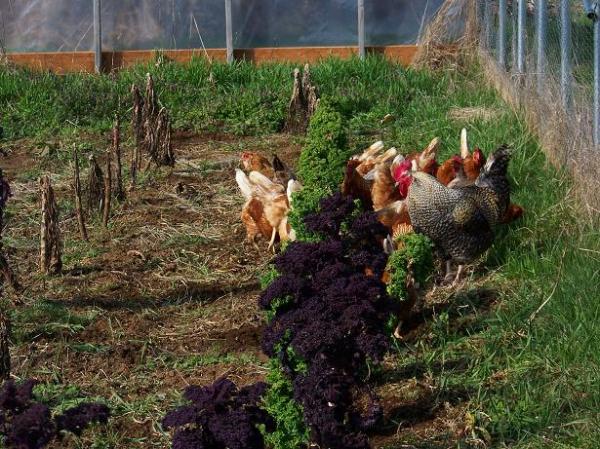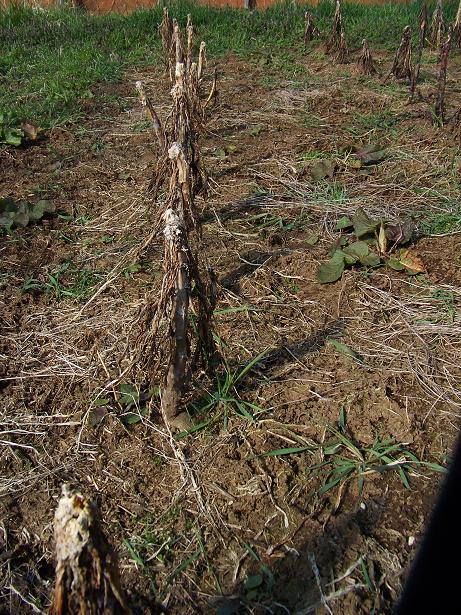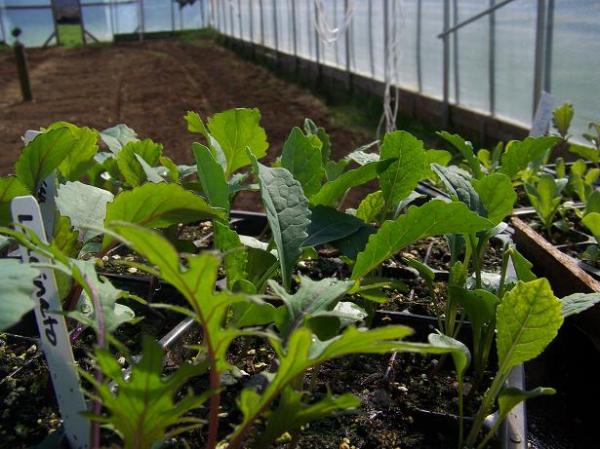Kale Calendar
 ale, the so last year brassica, plays a prominent role here in the garden; so much so, that it’s the one plant that we can grow that makes it through each month on the calendar. All in all, I actually think kale prefers the cold winter to the hot summer. It won’t keep in a summer salad mix like other greens do, but it’s pretty tasty and well worth growing any month of the year. It’s hard to believe that the Redbor pictured below was seeded last June, planted in the greenhouse in July and has made it through the winter.
ale, the so last year brassica, plays a prominent role here in the garden; so much so, that it’s the one plant that we can grow that makes it through each month on the calendar. All in all, I actually think kale prefers the cold winter to the hot summer. It won’t keep in a summer salad mix like other greens do, but it’s pretty tasty and well worth growing any month of the year. It’s hard to believe that the Redbor pictured below was seeded last June, planted in the greenhouse in July and has made it through the winter.
You never really know here in the Pacific Northwest just what winter will bring. So you plan for the worst and hope for the best. It could be five feet of snow that smashes your greenhouses or it could be 5F temps that freeze your formally winter hardy crops. I planted my usual cast of kales for winter, because they are the most prolific and cold hardy green and I depend on them for greens for the hens and us too, of course.
I planted Lacinato, Rainbow Lacinato, Hunger Gap, Red Russian, White Russian, WinterborF1, and Redbor F1. My only survivors are Rainbow Lacinato and the “bors”. That’s a garden trial, same conditions, survivors take all. Some winters the others make it, but gardening is about extremes. Hot, cold, wet or dry, now I definitely know I won’t waste anytime planting certain kales for winter fare. Many other folks won’t be either…I have heard that some of the hybrid kales are already sold out for 2014.
I made a deal with the chickens yesterday after putting the cover on the greenhouse – you do some weeding for me, and I’ll let you have as much kale as you can stand. Deal? We’ll eat the kale in the garden and the chickens can help themselves in the greenhouse.


So far so good, it didn’t take long to move them, although Russell Crow was not liking the indignity of being carried to his new digs. Add a nest box, waterer, and feeder and they were happy to get to work.








That will make for some orange yolks.
I don’t know how you do it all. I don’t carry an ounce of extra weight. I have worked it all off. And I can’t begin to consider starting flats of brassicas.
HFS, it does keep the color pretty good all winter, as long as the kale keeps up. I’m not sure if pulsing that grass in the greenhouse will be a help or a hindrance, but at least I don’t have to pack the kale to them, they can get it themselves.
Well, actually I started those flats a month ago, planted some, and have started some more…and I don’t do “it” all. Lots of stuff doesn’t get done. You know how that is.
I’m still waiting to see what (if anything) made it through the winter here in upstate NY; we didn’t have record breaking cold temperatures, but it was very cold for a lot longer than the average winter.
I would agree with you on Rainbow Lacinato; I plant that and White Russian, and generally the Rainbow plants are more likely to overwinter for me and give me shoots the next spring.
Victoria, it was cold here (more than usual) but normally with the cold we get some snow insulation, but this winter was pretty dry, so no snow and lots of frozen plants 😦
Finally got to plant the first round of things yesterday (lettuce, spinach, peas, kale, collards). None of last year’s kale made it, but about 80% of the carrots and parsnips did. We had some snow insulation, but apparently it wasn’t deep enough to keep the kale going.
Have you ever had a problem with wire worms? I overwintered beets in a raised bed a year ago and the wire worms came in to stay. I’m trying to sift them out as I dig in new compost this year, but they are sneaky little buggers that can ruin a bunch of newly transplanted lettuce, potatoes or kale!
Dana, you know the only time I see wire worms is when I open a new garden spot, it seems they like the sod, but I have never seen them after the first growing season. They are buggers!
You must have the yellowest egg yolks in town. Now, I’m wondering with all that purple Kale that your chickens have access to, if your yolks will take on a little pink hue? 🙂
No pink yolks, but I do see pink poop once in awhile, especially when they get beets 🙂
We are just heading into autumn here down under and kale is a stalwart of my winter garden too. It will feed us and our chooks plus the rabbit tidbits for many months.
While we dont get a lot of snow where I am – maybe a couple of falls a year, and our cold is nothing like what you have been experiencing, its nice to learn from other food growers no matter where they live.
I hear you on the kale – I plant lots – as many kinds as I can get my hands on – unbelievably hardy. And yes – because everybody has jumped on the ‘kale superfood’ bandwagon – last year there wasn’t a kale seed to be had through the seed catalogues. My mom managed to grab some dwarf kale seeds from the coast, my aunt found some Russian kale seeds from a seed saver at a farmers market in the okanagan, one of the mechanics I work with found some Siberian variety at the university plant sale where I live. Ridiculous – but I had lots of kale growing. 😊
Haven’t bought kale, or arugula seeds, in about a decade. I always let a few biennial plants go to seed. I both gather the seed, as well as letting some drop for volunteer seedlings mid- summer, these then over winter ( except in 2014!). I like red russian kale best, hardy winter picking here on Martha’s Vineyard, Massachusetts , also less cabbage moth and aphid destruction than other types. Just now it’s 25f and our first snow, am headed out to pick a bunch for soup- it will have been frost sweetened by now, and just what the body wants in the New Year!
Hey, Nita, did my previous comment here get eaten by the website monster? It didn’t go to its usual “your comment is awaiting moderation.”
Bee, nope it was there, I didn’t time to answer when I approved it though. I haven’t heard of that disease, yet…but I have heard of a chicken bursal disease in Washington. 😦
Apparently it’s spread through hog feces. Highly, highly contagious, but only to pigs — mortality rate is close to 100% in piglets if it hits in the first three weeks. Adults get sick but not as badly and usually recover. No treatment except supportive care. It’s devastating the pig farmers in many states. On the other hand, they’re raising them in confinement, which is just asking for trouble IMHO.
Exactly!
I’ve been singing the praises of kale for a few years now for exactly the reason you cite: it really does grow year ’round, and if you only had room for a few veg you could feed yourself pretty well on kale and zucchini. Oh you’d get sick of it, but you wouldn’t starve. Except this winter. You know how we had those two really good freezes? Well, they knocked out all the kale I had growing in the open.
But you know what laughed off the freezes and shook off the snow? Collards. My collards did really well, so I’ll be starting more collards for next winter for sure. Who knew?
Paula, man that was cold, all my kale was outside too, it either died or lived with no in-between. We took the cover off the greenhouse in November so the kale that was inside got no special treatment. I didn’t plant collards but was pleased to see the Melissa savoy cabbage made it, a little worse for wear but with some trimming it was fine. I hope we don’t have repeat of this past winter but at least now we know.
This year is Rainbow Lacinato, Red Russian, and Vates. Vates is a customer favorite. Here in Western Mass we hit -20F and nothing survives the winter. I started my kale March 1 and it’s doing fine. Will soon need to go to the cold frame, but last night was 10F, and not to warm any until the weekend.
Ha! Kind of like our pink pee when we eat beets…ok, sorry…TMI 🙂
have you ever tried collecting seed from those overwintered ones once they flower the second year? Also I have had great luck with red russian overwintering even here in zone 3.5! So tender, it’s my fav.
Yes, but not every year…the seed keeps a long time and I have to alternate with rutabagas 🙂
I do love collards, and they taste better in hot weather than kale, and aren’t as plagued by bugs. But they can be tough, so need to cook longer, which some folks don’t care for. I am trying a new variety this year called Pilgrim Cabbage (Champion has been my champion so far) from Wild Garden seeds, excited to see how they do. And my rainbow lacinato (from the same place) laughed at the cold and snow, and I am happily eating the kale raab now. Plus it is a beautiful plant, and the chickens and the rabbits love it as much as I do.
Wow, your kale is so tall and tree-like! I’ve never seen that before. And what happy chickens 🙂